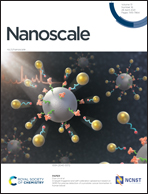Rational design of N-doped CNTs@C3N4 network for dual-capture of biocatalysts in enzymatic glucose/O2 biofuel cells†
Abstract
Carbonaceous materials are promising electrode materials for enzymatic biofuel cells (EBFCs) due to their excellent electrical conductivity, chemical and physical stability and biocompatibility. Design and preparation of carbon materials with a hollow structure and a rough surface are of great significance for immobilization of enzymes both inside and outside the carbon materials for EBFC applications. We report herein the synthesis of novel carbonaceous materials consisting of bamboo-shaped hollow N-doped carbon nanotubes (N-CNTs) and C3N4 nanosheets (denoted as N-CNTs@C3N4) as electrode materials for dual-capture of enzymes in glucose/O2 EBFCs. The combination of one-dimensional N-CNTs with an open structure and two-dimensional C3N4 nanosheets forms a three-dimensional crosslinking network that significantly enhances the immobilization of enzymes, electrode stability, and mass transfer of substrates, thus boosting the EBFC performance. As a result, EBFCs equipped with N-CNTs@C3N4 can generate a high open circuit potential of 0.93 V and output a maximum power density of 0.57 mW cm−2 at 0.47 V. Additionally, the as-fabricated glucose/O2 EBFCs are capable of directly harvesting energy from various soft drinks, which indicates the promising applications of the N-CNTs@C3N4 nanocomposite as an electrode material for EBFCs.



 Please wait while we load your content...
Please wait while we load your content...